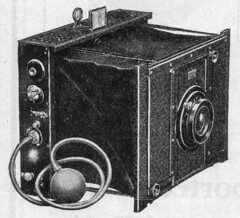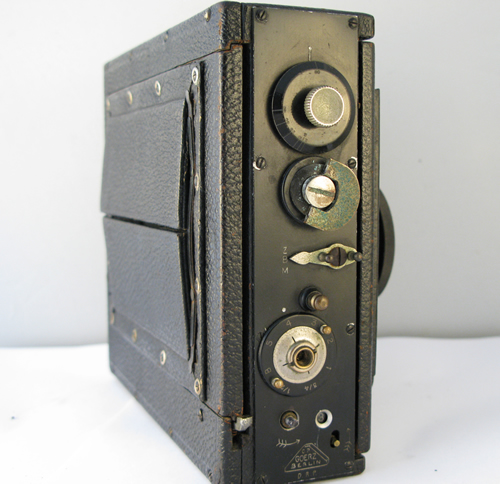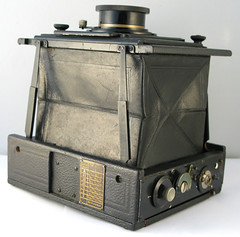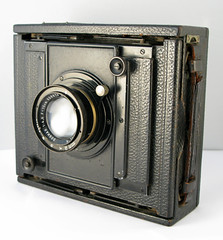Difference between revisions of "Goerz Anschütz Ango"
Hanskerensky (talk | contribs) m (→Links: Refined Link URL) |
m (→Links: Updated LPA links) |
||
| (4 intermediate revisions by 2 users not shown) | |||
| Line 28: | Line 28: | ||
|colspan=2|<center><small>Images by {{Image author|Rachel Rayns}}</small> {{with permission}} | |colspan=2|<center><small>Images by {{Image author|Rachel Rayns}}</small> {{with permission}} | ||
|} | |} | ||
| − | Many of [[Goerz|C.P. Goerz]]'s early cameras use the fast rouleau shutter that the company had licensed exclusively from its inventor Ottomar Anschütz of Lissa in Poznań <ref>Then 'Posen,' | + | Many of [[Goerz|C.P. Goerz]]'s early cameras use the fast rouleau shutter that the company had licensed exclusively from its inventor Ottomar Anschütz of Lissa in Poznań <ref>Then 'Posen,' a province of Germany</ref>. A long running series of such cameras was named '''Ango''', an abbreviation for Anschütz and Goerz. The series started in 1894 (though maybe not yet named "Ango"). The best-known of the 'Ango' cameras are [[folding|strut folding]] models with the Anschütz [[focal plane shutter]]. The cameras are wooden-bodied, with black leather covering and bellows. |
| − | These cameras have a rather complex set of shutter controls on one side of the body, since early focal plane shutters needed more than one control element to set the speed. A combination of slit width setting and rouleau speed setting gave the shutter speed. Until 1905 the slit width had to be set inside the camera. On the opposite side of the camera | + | These cameras have a rather complex set of shutter controls on one side of the body, since early focal plane shutters needed more than one control element to set the speed. A combination of slit width setting and rouleau speed setting gave the shutter speed. Until 1905 the slit width had to be set inside the camera. On the opposite side of the camera is its grip. The camera has a folding Newton finder; most examples seen have a blue filter in the eyepiece of this, and crosshairs on the front lens. It can also be used with a ground-glass screen, like most plate cameras. The camera has helical focusing (compare to the strut-folders by [[Nettel]], such as the [[Deckrullo-Nettel]], which focus by adjustable strut extension). The lens board allows front rise and shift. |
As the '''High-Speed Ango''', such cameras were still available in 1922, for plate sizes 3¼x4¼", 4x5", 5x7" and 10x15cm , and equipped with Goerz Dogmar f/4.5 lens. | As the '''High-Speed Ango''', such cameras were still available in 1922, for plate sizes 3¼x4¼", 4x5", 5x7" and 10x15cm , and equipped with Goerz Dogmar f/4.5 lens. | ||
| Line 56: | Line 56: | ||
==Links== | ==Links== | ||
*[http://www.ottomar-anschuetz.de/fotoapparate.htm Anschütz Kameras of Goerz] at [http://www.ottomar-anschuetz.de www.ottomar-anschuetz.de] | *[http://www.ottomar-anschuetz.de/fotoapparate.htm Anschütz Kameras of Goerz] at [http://www.ottomar-anschuetz.de www.ottomar-anschuetz.de] | ||
| − | * Ango cameras sold at past auctions by [ | + | * Ango cameras sold at past auctions by Westlicht Photographica Auction (now [https://www.leitz-auction.com/auction/en/home Leitz Photographica Auction]): |
| − | ** [ | + | ** [https://www.leitz-auction.com/en/Goerz-Ango/AI-9-27107 9x12 cm Ango], serial no. 32909, dated about 1906, with a 13.5 cm f/6.8 Dagor Series III, and blue-filtered Newton finder, at the [https://www.leitz-auction.com/en/Cameras/Past-Auctions/Auction-9/ ninth auction] (20 May 2006). |
| − | ** [ | + | ** [https://www.leitz-auction.com/en/Goerz-Ango/AI-19-12777 8x10 cm Ango], serial no. 47110, dated about 1911, with a 13.5 cm f/6.8 Dagor lens, and blue-filtered Newton finder, at the [https://www.leitz-auction.com/en/Cameras/Past-Auctions/Auction-19/ nineteenth auction] (28 May 2011). |
| − | ** [ | + | ** [https://www.leitz-auction.com/en/Goerz-Anschutz-stereo/AI-2-21602 9x18 cm Stereo-Ango], serial no. 19504, dated about 1910, with 120 mm f/6.8 Dagor lenses, and with ''three'' Newton finders, one for stereo and one for each lens used separately; sold at the [https://www.leitz-auction.com/en/Cameras/Past-Auctions/Auction-2-3/ second/third auction] (23 May 2003). |
| − | ** [ | + | ** [https://www.leitz-auction.com/en/Goerz-Anschuetz-stereo/AI-2-21603 9x18 cm Stereo-Ango], serial no. 21378, dated about 1920; similar to the one above, but with a single, blue-filtered Newton finder; also sold at auction 2/3. |
*[http://www.collection-appareils.fr/x/html/page_standard.php?id_appareil=10978 Goerz Anschutz 13x18] at [http://www.collection-appareils.fr/general/html/francais.php Sylvain Halgand's www.collection-appareils.fr] (in French) | *[http://www.collection-appareils.fr/x/html/page_standard.php?id_appareil=10978 Goerz Anschutz 13x18] at [http://www.collection-appareils.fr/general/html/francais.php Sylvain Halgand's www.collection-appareils.fr] (in French) | ||
| Line 69: | Line 69: | ||
[[Category:1890-1899]] | [[Category:1890-1899]] | ||
[[Category: A|Ango]] | [[Category: A|Ango]] | ||
| − | [[Category:Goerz]] | + | [[Category:Goerz|Anschütz Ango]] |
[[Category:9x12 strut folding]] | [[Category:9x12 strut folding]] | ||
[[Category:8x10.5 folding]] | [[Category:8x10.5 folding]] | ||
[[Category:9x18 stereo]] | [[Category:9x18 stereo]] | ||
Latest revision as of 09:10, 2 April 2024
| |||||
|
| ||||
Many of C.P. Goerz's early cameras use the fast rouleau shutter that the company had licensed exclusively from its inventor Ottomar Anschütz of Lissa in Poznań [1]. A long running series of such cameras was named Ango, an abbreviation for Anschütz and Goerz. The series started in 1894 (though maybe not yet named "Ango"). The best-known of the 'Ango' cameras are strut folding models with the Anschütz focal plane shutter. The cameras are wooden-bodied, with black leather covering and bellows.
These cameras have a rather complex set of shutter controls on one side of the body, since early focal plane shutters needed more than one control element to set the speed. A combination of slit width setting and rouleau speed setting gave the shutter speed. Until 1905 the slit width had to be set inside the camera. On the opposite side of the camera is its grip. The camera has a folding Newton finder; most examples seen have a blue filter in the eyepiece of this, and crosshairs on the front lens. It can also be used with a ground-glass screen, like most plate cameras. The camera has helical focusing (compare to the strut-folders by Nettel, such as the Deckrullo-Nettel, which focus by adjustable strut extension). The lens board allows front rise and shift.
As the High-Speed Ango, such cameras were still available in 1922, for plate sizes 3¼x4¼", 4x5", 5x7" and 10x15cm , and equipped with Goerz Dogmar f/4.5 lens.
There were also Ango Luxus cameras, and stereo models, the Ango Stereo and Ango Stereo Luxus.
Production of the Ango ceased in 1926 or 1927 as a result of Goerz merger into Zeiss Ikon. [2]
A folding SLR version of the camera, the Reflex-Ango was made, with reflex focusing.

|
| advertised as High-Speed Ango in 1922 scanned by Uwe Kulick (Image rights) |
Notes
- ↑ Then 'Posen,' a province of Germany
- ↑ Anschütz Kameras of Goerz.
Links
- Anschütz Kameras of Goerz at www.ottomar-anschuetz.de
- Ango cameras sold at past auctions by Westlicht Photographica Auction (now Leitz Photographica Auction):
- 9x12 cm Ango, serial no. 32909, dated about 1906, with a 13.5 cm f/6.8 Dagor Series III, and blue-filtered Newton finder, at the ninth auction (20 May 2006).
- 8x10 cm Ango, serial no. 47110, dated about 1911, with a 13.5 cm f/6.8 Dagor lens, and blue-filtered Newton finder, at the nineteenth auction (28 May 2011).
- 9x18 cm Stereo-Ango, serial no. 19504, dated about 1910, with 120 mm f/6.8 Dagor lenses, and with three Newton finders, one for stereo and one for each lens used separately; sold at the second/third auction (23 May 2003).
- 9x18 cm Stereo-Ango, serial no. 21378, dated about 1920; similar to the one above, but with a single, blue-filtered Newton finder; also sold at auction 2/3.
- Goerz Anschutz 13x18 at Sylvain Halgand's www.collection-appareils.fr (in French)


